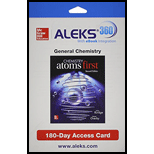
Interpretation:
The age of the rock has to be determined from the given options.
Concept introduction:
- Unstable nuclei emit radiation spontaneously to become stable nuclei by losing energy. This process of emission of radiation by unstable nuclei is known as radioactive decay.
- Radioactive decay is in the first order kinetics. Rate of radioactive decay at a time t is,
Answer to Problem 19.4KSP
The correct option for the age of rocks is given in option (a)
Explanation of Solution
Reason for correct option
To find: The age of the rock
The age of the rock is
The age of the rock is calculated
Given,
Some of
Hence,
The initial mass of
The age of the rock can be calculated by the equation.
Therefore,
The age of the rock is,
The age of the rock is
Hence the correct option for the age of the rock is option a.
Reasons for incorrect options:
Write all the age of the rock given in the options except option a.
(b)
(c)
(d)
(e)
The age of the rock is found as
So, this value of the age of the rock is not matching with any of the above given the age of the rock in remaining options.
Hence the incorrect options are b, c, d and e
The correct option for the age of the rock is identified from the given options. The age of the rock is determined by using the data’s given for the radioactive decay.
Want to see more full solutions like this?
Chapter 19 Solutions
Aleks 360 Access Card (1 Semester) For Chemistry: Atoms First
 ChemistryChemistryISBN:9781305957404Author:Steven S. Zumdahl, Susan A. Zumdahl, Donald J. DeCostePublisher:Cengage Learning
ChemistryChemistryISBN:9781305957404Author:Steven S. Zumdahl, Susan A. Zumdahl, Donald J. DeCostePublisher:Cengage Learning ChemistryChemistryISBN:9781259911156Author:Raymond Chang Dr., Jason Overby ProfessorPublisher:McGraw-Hill Education
ChemistryChemistryISBN:9781259911156Author:Raymond Chang Dr., Jason Overby ProfessorPublisher:McGraw-Hill Education Principles of Instrumental AnalysisChemistryISBN:9781305577213Author:Douglas A. Skoog, F. James Holler, Stanley R. CrouchPublisher:Cengage Learning
Principles of Instrumental AnalysisChemistryISBN:9781305577213Author:Douglas A. Skoog, F. James Holler, Stanley R. CrouchPublisher:Cengage Learning Organic ChemistryChemistryISBN:9780078021558Author:Janice Gorzynski Smith Dr.Publisher:McGraw-Hill Education
Organic ChemistryChemistryISBN:9780078021558Author:Janice Gorzynski Smith Dr.Publisher:McGraw-Hill Education Chemistry: Principles and ReactionsChemistryISBN:9781305079373Author:William L. Masterton, Cecile N. HurleyPublisher:Cengage Learning
Chemistry: Principles and ReactionsChemistryISBN:9781305079373Author:William L. Masterton, Cecile N. HurleyPublisher:Cengage Learning Elementary Principles of Chemical Processes, Bind...ChemistryISBN:9781118431221Author:Richard M. Felder, Ronald W. Rousseau, Lisa G. BullardPublisher:WILEY
Elementary Principles of Chemical Processes, Bind...ChemistryISBN:9781118431221Author:Richard M. Felder, Ronald W. Rousseau, Lisa G. BullardPublisher:WILEY





